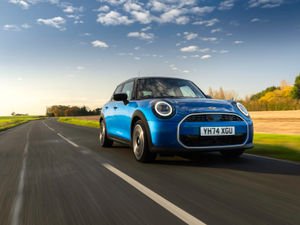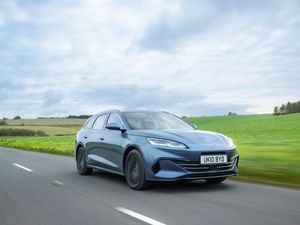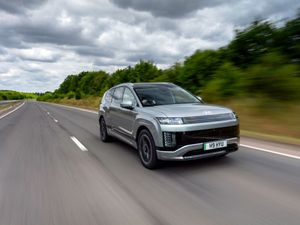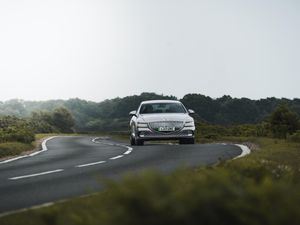First drive: Is the SsangYong Korando e-Motion the best value electric SUV?
SsangYong has finally brought an electric version of the Korando to the UK. We see if it’s been worth the wait.
What is it?

>
SsangYong is a car brand that’s long been at the edges of the UK car market. Loved by farmers and caravan owners, its cars have traditionally been bought by people who care more about solid reliability and value for money than badge appeal.
That’s steadily been changing over the past few years, though, with models like the Musso rising to the top of the pick-up market. Now, the South Korean carmaker has its eyes on the flourishing electric car segment, and the Korando e-Motion is its first EV to go on sale in the UK.
What’s new?

>
SsangYong’s first EV isn’t a bespoke, clean-sheet-of-paper design. Instead, the firm has taken its Korando small SUV, added an electric powertrain and smoothed over the styling to make it more aerodynamic. That’s no bad thing as a key battle in the EV sector is the sub-£32,000 market – or, in other words, where the Government’s Plug-in Car Grant ends.
What’s under the bonnet?

>
Power comes from a single electric motor hooked up to the front wheels. With 188bhp, the Korando is more powerful than the MG ZS EV and Mazda MX-30, and just a little shy of the Hyundai Kona 64kWh. The e-Motion tops out at 97mph and while there’s no claimed figure yet for the 0-60 sprint time, in our test drive it felt around eight seconds which is comparable to the car’s nearest rivals.
The electric motor is powered by a 61.5kWh battery (55.3kWh useable), which gives a claimed 210 miles of range. In our testing on a cold winter’s day, a 100 per cent change was giving a displayed 200 miles and the range dropped mile for mile.
As for charging, the battery can be charged at speeds of up to 100kW which means a 20-80 per cent top-up from a rapid charger takes just over half an hour. That rises to 54 minutes on a 50kW on-street charger, while an overnight charge from a 7kW wallbox should take 11 hours. If you’ve only got a three-pin socket to charge from, expect a full recharge to take 30 hours.
What’s it like to drive?

>
Even within a few hundred metres of setting off the e-Motion feels completely different from the petrol- and diesel-powered versions, and that’s because of how quiet it is to travel in.
That might sound like an obvious thing to say of an electric car, but it’s especially evident in the Korando because of the absence of its unrefined diesel engine and hesitant automatic gearbox.
More than that, SsangYong has added a whole heap of sound deadening within the body panels and behind the dashboard, and there’s even a different type of front subframe to reduce vibrations. And it really works – it’s eerily quiet, even on the motorway.
With 188bhp and 360Nm of torque, the e-Motion is the quickest Korando you can buy. Squeeze the throttle hard and acceleration isn’t neck-snapping, but it’s nicely progressive and quick enough. There’s no ‘b-mode’ for extra brake regeneration, instead paddles behind the steering wheel control three settings of regen. Even in the highest setting, there’s no Nissan Leaf-like one-pedal driving, but it does a good job at recouping a bit more energy.
Elsewhere the e-Motion is just like other Korandos with decent body control, responsive steering and a stiff ride. Having said that, the e-Motion’s aero-friendly 17-inch alloys do give a slightly more cushioned ride compared to some top-spec petrol and diesel Korandos with 19-inch wheels.
How does it look?

>
Just like MG and Hyundai, SsangYong has gone for a smoothed-off look to differentiate the electric version from petrol and diesel models, adding a cleaner front bumper and tweaked rear bumper.
The headlights and rear lights are different too, as is a new boot trim with ‘Korando’ proudly blazoned across it, and a set of aerodynamic – but rather plain-looking – alloy wheels. But, essentially, it’s a subtle makeover. It certainly looks smart but some of the Korando’s rather crisp lines have disappeared though, which we think is a bit of shame.
SsangYong UK has actually removed much of the blue trim found on Korean-spec cars, but we still think there’s rather too much of it.
What’s it like inside?

>
Compared to other small electric crossovers-cum-SUVs, the Korando’s interior is well put together with some plush-feeling materials.
There’s yet more blue trim dotted around the cabin, and even the tops of the dashboard and doors are finished in blue soft-touch plastic, but it nicely brightens up the interior. The e-Motion gets a brand new 12.3-inch display in front of the driver, which has super crisp graphics and it can even mirror your smartphone’s screen.
The Korando has a real bonus compared with rivals from MG, Kia, Hyundai and Mazda – and that’s space. Headroom is very generous and the rear legroom is positively enormous. At 551 litres, the boot is over 200 litres larger than the Hyundai Kona Electric’s, and mid-spec models and above get a handy moveable floor that can also act as a boot divider.
What’s the spec like?

>
There are three versions of the e-Motion to choose from. The ELX kicks things off with 17-inch alloys, the digital driver’s display, an eight-inch touchscreen with Apple CarPlay and Android Auto, a rear view camera, dual-zone climate control and a whole heap of safety equipment, including lane keep assist and adaptive cruise control. At £31,995, the ELX just sneaks in under the Government’s Plug-in Car Grant and gets the £1,500 subsidy.
Ventura comes in at £34,995 and adds more handy features like LED headlights, a nine-inch touchscreen, heated front seats, the clever boot floor and importantly a charging cable – not always standard equipment on electric cars at the value end of the market.
Ultimate tops the range and while its £37,995 seems very punchy, it’s loaded with kit such as leather upholstery, electric front seats (which are also ventilated), a powered tailgate, front and rear parking sensors and a wireless phone charger. Impressively, SsangYong has also thrown in a heat pump on Ultimate models – this heating system can significantly extend the driving range of an EV in the winter and is normally a costly optional extra.
Verdict
SsangYong first mooted its intentions to launch an electric version of the Korando way back in 2019, and it’s certainly taken its time to make good on the promise. Since then the electric crossover market has mushroomed with the launch of cars like the MG ZS EV, Kia e-Niro and Peugeot e-2008, but the Korando e-Motion’s arrival is still well-timed.
It’s decent enough to drive, super refined and its 200-odd-mile range is bang on the money. Speaking of money, the Korando could do with being slightly cheaper, but it is well equipped and is considerably more spacious and practical than its rivals. The e-Motion is not just the pick of the two-wheel-drive Korandos, but also seriously worthy of consideration for anyone looking at the more value-end of the electric market.





